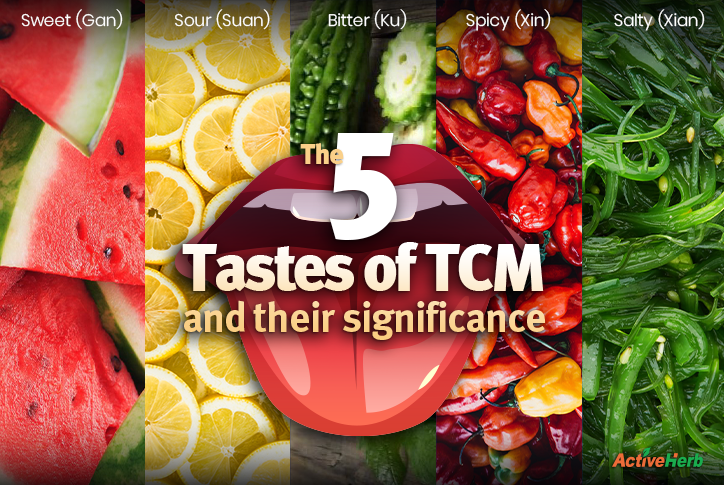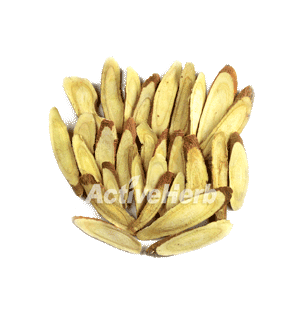How To Use The 5 Tastes of TCM To Balance Your Health

Meet the 5 tastes of TCM: Suan. Ku. Gan. Xin. Xian. You know them as sour, bitter, sweet, spicy, and salty, respectively.
In the West, these five flavor profiles tickle our taste buds and from there, taste messages from the tongue are eventually carried to the thalamus in the brain, where we receive the message that it was a really bad decision to try the Carolina Reaper chili pepper—registering 2.2 million on the Scoville Heat Unit (SHU).
In the West, the five flavor profiles are taste sensations, no more and no less, with the rare exception of using digestive bitters. But in Traditional Chinese Medicine, they are part of a nutritional philosophy that can bring balance to the body. (Lesson #1: just say no to the Carolina Reaper!)
The Five Tastes of TCM and Their Significance
Chinese herbs and acupuncture receive most of the spotlight when it comes to maintaining or pursuing balance in the body. But TCM also places a large emphasis on nutrition. And it’s not just what you eat that matters for health, it’s also how they tickle your taste buds. One fascinating aspect of TCM’s nutritional philosophy is the concept of the five tastes. (More accurately, in TCM they are described as “flavors.” But as anybody who has ever stepped into a Baskin Robbins ice cream shop knows, there’s lots more than 5 flavors to tickle the taste buds.)
Let’s get to know each of the 5 tastes of TCM and how they are associated with health.
Sour (Suan)
In TCM, sour is associated with the wood element and the Liver channel. If you have a sluggish Liver function (Liver Qi deficiency), consuming more sour foods may help if you have manifestations of Liver Qi deficiency such as bloating, low appetite, frequent sighing, and moodiness. Eating sour foods like lemons, green apples and vinegar may help stimulate Liver function, kickstarting the smooth flow of Qi, which in turn enhances blood flow.
Bitter (Ku)
The domain of the Fire element and the Heart and Small Intestine channels, Ku foods like bitter melons and dark leafy greens are a potent antidote to rebellious Qi. The energy (Qi) of digestion is supposed to move downward. But when you eat something that doesn’t agree with you, like the Carolina Reaper chili pepper, rebellious Qi causes an upward flow of energy. Hello, hiccups, belching or vomiting.
In addition to encouraging proper downward digestive Qi, Ku foods can clear heat, promote detoxification, and drain excessive dampness from the body.
Sweet (Gan)
In the West, rare is the description of sugar as “earthy”. That description seems to be reserved these days for edible mushrooms. But in TCM, the Gan flavor is associated with the Earth element and organ systems that are responsible for optimal digestion: the Spleen and Stomach organs.
In TCM nutritional philosophy, sweetness not only refers to artificial or added sugars pervasive in the Western diet. ‘Gan’ also refers to carbohydrates that metabolize much more slowly and are therefore far healthier than sugar. In other words, Gan describes complex carbs like legumes (lentils, beans) wild rice and other grains and tubers like sweet potatoes. One example of a famous TCM herb with a Gan flavor profile is Gan Cao, or licorice root, which is used to strengthen Spleen Qi and clear heat.
Spicy (Xin)
You can say that “Xin” foods are the spice of life. These Metal element foods like ginger, garlic and peppers act on the Lung and Large Intestine meridians. Used medicinally for supporting circulation, Xin foods disperse stagnant Qi, which can cause congestion.
Obviously, you don’t need to eat a Carolina Reaper chili pepper to experience the sweat-inducing qualities of Xin. But even mild sweating can have a balancing impact on health if you have an invasion of one of the 6 evils of TCM. That’s because Xin foods can drive out the pathogenic evil from the body.
Salty (Xian)
The last flavor profile is associated with the Water element and the Kidneys and Bladder. This makes sense from a Western perspective. After all, a high salt diet alters sodium balance, causing the kidneys to become sluggish and remove less water, resulting in higher blood pressure.
But salt, which could probably use a revamped PR campaign, may have some benefits from a TCM perspective. Xian foods have a softening and moistening effect that may help dissolve accumulations. Obviously, it’s not a good idea to eat packaged snack foods with tons of salt added to make them addictive. But naturally-salty foods such as sea vegetables promote health for most people, except those on a severely-restricted sodium diet.
Balancing the 5 Tastes of TCM for Health
Too much or too little of any one flavor can disrupt Yin/Yang balance in the body’s organ systems. TCM practitioners can use the five flavors/tastes to address specific health conditions.
For example, if someone is experiencing heat-related symptoms like inflammation, incorporating bitter foods can help cool the body and support a healthy inflammation level. You can also add Gan (sweet) properties to help battle other signs of heat and inflammation, such as skin redness and irritability.
So let’s get in the kitchen and prepare a meal rich in Ku-Gan qualities that may help:
- Greens: A salad with arugula and dandelion greens (Bitter)
- Fruits: Sliced pears (Sweet)
- Protein: Grilled salmon (Slightly Salty)
- Dressing: Lemon juice and olive oil (Sour and slightly Bitter)
Keeping our aprons on, now let’s whip up a meal that may help support digestion. What we’ll need is a spicy and sour-centric dish to enhance digestion and stimulate circulation.
- Soup: A hot and sour soup with tofu and shiitake mushrooms (Sour and Spicy)
- Main Dish: Stir-fried vegetables with a touch of chili paste (Spicy)
- Side: Pickled vegetables or kimchi (Sour)
Combining these Suan and Kin ingredients encourages Qi circulation and helps to invigorate the digestive process.
In addition to herbal formulas that may help support normal inflammation, eating a meal like this may help cool and soothe the body, helping to address the excess heat and inflammation.
A Balancing Meal For Menopausal Symptoms
For peri- or postmenopausal ladies, the depletion of estrogen and progesterone hormones can cause Kidney Yin deficiency, leading to symptoms such as hot flashes and dryness. So let’s prepare a Yin-nourishing meal by emphasizing the Sweet (Gan) and Sour (Suan) flavors:
- Grains: Cooked oats with a drizzle of honey (Sweet)
- Fruits: Stewed apples or pears with a touch of cinnamon (Sweet)
- Beverage: Warm lemon water (Sour)
The Perfect Meal for the Spleen-Qi Deficient
Rare is the person who doesn’t have Spleen Qi deficiency. Just ask your acupuncturist. So this meal may benefit nearly everybody’s food-transforming and nutrient-transporting Spleen organ tasks. Here’s what the chef has whipped up for a savory (which is sometimes included as the sixth taste profile), Spleen-strengthening meal:
- Starch: Quinoa (Sweet)
- Protein: Baked white fish (Slightly Sweet)
- Vegetables: Steamed carrots and sweet potatoes (Sweet)
- Seasoning: A dash of ginger and a sprinkle of sesame seeds (Spicy)
A Balanced Meal Using the 5 Tastes Of TCM
Finally, let’s create a well-balanced meal that embodies the principles of the Five Flavors:
- Protein: Grilled chicken (Salty and slightly Spicy)
- Starch: Brown rice (Sweet)
- Vegetables: Steamed broccoli (Bitter) and sautéed bell peppers (Sour)
- Seasoning: A sprinkle of ginger (Spicy)
This meal encompasses all five flavors, creating a harmonious culinary composition that supports various organ systems. Keep in mind, however, that even this perfectly-balanced meal may not be suitable for your specific constitution or health concerns. Visit your local acupuncturist and ask them which of the 5 TCM flavors you should have more of and which ones you should restrict.
In TCM theory, the Five Flavors remind us that health is a reflection of balance, both on our plates and in our lives.







